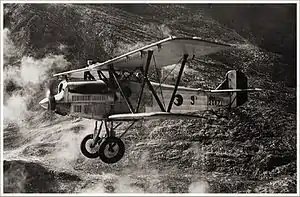Fiat CR.20
The Fiat CR.20 was an Italian biplane fighter used during the 1920s and 1930s. Designed by Celestino Rosatelli, it represented an intermediate step from the early biplane CR.1 and the later, successful series CR.30, CR.32 and CR.42.
| CR.20 | |
|---|---|
 | |
| Role | Fighter |
| Manufacturer | Fiat |
| Designer | Celestino Rosatelli |
| First flight | June 19, 1926 |
| Primary users | Regia Aeronautica Lithuanian Air Force Hungarian Air Force |
| Number built | c. 250 CR.20 c. 46 CR.20 Idro c. 235 CR.20bis c. 204 CR.20 Asso |
Design and development
For the new aircraft, Rosatelli used a traditional sesquiplane configuration. The engine was a water-cooled 306 kW (410 hp) Fiat A.20 V-12 engine.
Major variants were the CR.20 Idro, a pontoon floatplane, and the CR.20 Asso, using a more powerful (336 kW/450 hp) Isotta Fraschini engine. CR.20bis, produced from 1930, differed from the original version only with the addition of a more advanced landing gear.
At its peak in 1933, the CR.20 equipped 27 squadrons of the Italian Regia Aeronautica. The aircraft was used against Libyan rebels and in the early stages of the Second Italo-Abyssinian War in the attack role.[1] The CR.20s remained in service with the Regia Aeronautica in the aerobatics and training until the 1930s. In 1933, Italy sold five CR.20s to Paraguay, which was fighting the Chaco War against Bolivia, these serving as Paraguay's only fighters through to the end of the war.[2]
Variants
- CR.20 Idro : Twin-float seaplane version.
- CR.20bis : Single-seat fighter biplane, fitted with an advanced landing gear.
- CR.20bisAQ : CR.20bis aircraft fitted with the Fiat A.20 A.Q. piston-engine.
- CR.20 Asso : Single-seat fighter biplane, powered by a 336 kW (450 hp) Isotta Fraschini Asso Caccia engine.
- CR.20B : Two-seat trainer, communications aircraft. Built in small numbers.
Operators
- Lithuanian Air Force - 15 units, 1928-1940.[3][4]
- Soviet Air Force - Two aircraft, used for tests and trials.[4]
Specifications (CR.20)

Data from The Complete Book of Fighters [5]
General characteristics
- Crew: 1
- Length: 6.7 m (22 ft 0 in)
- Wingspan: 9.8 m (32 ft 2 in)
- Height: 2.75 m (9 ft 0 in)
- Wing area: 25.65 m2 (276.1 sq ft)
- Empty weight: 980 kg (2,161 lb)
- Gross weight: 1,400 kg (3,086 lb)
- Powerplant: 1 × Fiat A.20 V-12 water-cooled piston engine, 331 kW (444 hp)
- Propellers: 2-bladed fixed-pitch propeller
Performance
- Maximum speed: 270 km/h (170 mph, 150 kn)
- Range: 750 km (470 mi, 400 nmi) [6]
- Endurance: 3 hours
- Service ceiling: 7,500 m (24,600 ft) [7]
- Time to altitude: 5,400 m (17,717 ft) in 13 minutes 37 seconds
Armament
- Guns: 2 × 7.7 mm (.303 in) machine guns
See also
Related development
Aircraft of comparable role, configuration, and era
Related lists
References
- Taylor 1981, pp. 54–55.
- von Rauch 1976, pp. 210–211.
- "Fiat CR.20". Plieno sparnai (in Lithuanian).
- CR.20. "Fiat CR.20". Airwar.ru (in Russian).
- Green and Swanborough 1990, p. 205.
- Angelucci 1983, p. 124.
- Taylor 1981, p. 54.
Bibliography
- Angelucci, Enzo. The Rand McNally Encyclopedia of Military Aircraft, 1914-1980. San Diego, California: The Military Press, 1983. ISBN 0-517-41021-4.
- Green, William and Gordon Swanborough. The Complete Book of Fighters. New York:Smithmark, 1994. ISBN 0-8317-3939-8.
- von Rauch, Gerd. "The Green Hell Air War". Air Enthusiast Quarterly, Number Two, 1976, pp. 207–213. Bromley, UK:Pilot Press.
- Sapienza, Antonio Luis (September 1994). "Les chasseurs Fiat au Paraguay" [Paraguayan Fiat Fighters]. Avions: Toute l'aéronautique et son histoire (in French) (19): 9–13. ISSN 1243-8650.
- Taylor, Michael J.H. Warplanes of the World 1918-1939. London: Ian Allan, 1981. ISBN 0-7110-1078-1.